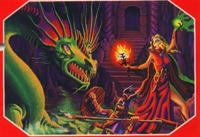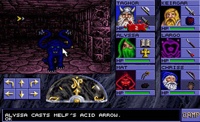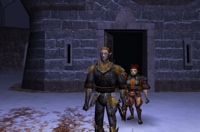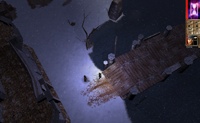The camera in Neverwinter Nights sucks. This article is about why. I’m telling you what the article is about up front, because I’m about to take a leisurely detour through many seemingly unrelated topics before circling back around to the actual point.
As I think I’ve mentioned before, my mother didn’t like Dungeons & Dragons very much. When I would hang out at Junot Diaz’s house and play all day, she’d always call me after a few hours and harangue me into coming home. This made me bitter, because everyone else got to stay there all day and most of the night playing, and I only got a taste of it. At the time, I was convinced that my mother didn’t understand how cool D&D was, and how creative and fun it was, and she just hated me and didn’t want me to have any friends at all.
Now, with the perspective of many years, I’ve finally come to understand that my mom didn’t hate D&D. She didn’t think it was satanic, or evil, or unbalancing, or immoral. In fact, she probably didn’t know anything about it whatsoever. My mom applied a very simple and sensible test: anything a 14 year old boy is willing to spend 20 hours in a basement doing can’t possibly be a good idea. I can’t really argue with that. Mom was right.
There was at least one unintentional side-effect of this, though. By constraining my D&D experiences, Mom turned the game into one of my semi-permanent latent objects of desire. Even though I personally have never had all that much fun playing D&D, either in person or on a computer, I’m convinced that somewhere within the maze of rules, tables, and Erol Otus drawings lies the joyous heart of all ludic pleasure. So, years later, the 14 year old in my head still wants me to purchase Dungeons & Dragons-based computer games.
Mom did let me spend 20 hours a day playing computer games, presumably because of a misbegotten belief that computers would somehow make me smarter.
One of the games I spent hours and hours playing was SSI’s classic dungeon crawl Eye of the Beholder. This game still holds up well (under emulation) even today. The rules were simple, the puzzles were surprisingly sophisticated given the limitations of its user interface, and it moved at just the right pace. Eye of the Beholder took everything good about Wizardry and imported it wholesale into a Dungeons & Dragons universe. The first two Eye of the Beholder games are the best computer-based dungeon crawls that have ever been made.
Recently, I heard about a mod for Neverwinter Nights that basically reimplements Eye of the Beholder in the NWN engine. So of course, I have to have it. It doesn’t matter that it won’t be as good as the original. It doesn’t matter that I own the original and can still play it on just about any machine, under emulation.
It’s shinier. I have to have it. The only problem is that in order to play it, I would have to buy the latest add-on pack for Neverwinter Nights, which I didn’t yet own (and suddenly, the reason this module is being touted on Bioware’s site becomes clear: now that’s good marketing).
Since I have a job and the add-on pack isn’t that much money, I bought it.
Before purchasing the add-on pack, I fired up Neverwinter just to refresh my memory. And that’s when the trouble began. Now, I’m going to compare Neverwinter Nights to its console nephews, Knights of the Old Republic and Jade Empire. I’m well aware that those are later games, and that they were able to learn from the mistakes made by Neverwinter. But it needs to be said: the single biggest misfeature of Neverwinter Nights as a product is that the camera is terrible.
I don’t work for Bioware. Despite the fact that they liked my little Jade Empire-inspired toy, The Inscrutable Denominator of Heavenly Glory, I’ve never hung out with them, drunk beer with them, or gone on press junkets with them (memo to Bioware: have your people call my people. Let’s do lunch). Despite that, due to my amazing psychic powers, I can tell you exactly how Neverwinter Nights ended up with its lousy camera.
Early in the development cycle, one of the engine programmers produced an internal-use-only demo of the 3D engine. The demo had various 3D objects arrayed around a landscape. To show how cool and truly-3D everything was, he provided some simple controls to drive the camera around via the keyboard. At the same as time the engine was being developed, work on other parts of the product was advancing: 3D models were being created, scripts were being written, and levels were being designed.
At some point, a year before the game was released, in mid-February — these things always happen in February, no one knows why — a meeting was held to determine what camera angle should be used in the actual game. The modelers and artists wanted a low, tight camera so that the beauty and detail of their work would be apparent. The programmers wanted a god’s-eye view so that the player could plan their strategy. The producer wanted a view between those two extremes because that seemed the least likely to cause a mutiny in his ranks. The level designers were insistent that if the angle of the camera was too low, the player would never figure out where to go and their game would be ruined, ruined! The graphic designers pointed out that if the camera was zoomed out too far, the game looked like a much less attractive version of Diablo. Harsh words were said. Snarky emails were exchanged. Finally one of the engine programmers, figuring he has already spent the time making the flyaround functionality work, says “Let’s just leave the demo controls in. Then the player can figure out the best view for himself.”
The result, of course, is that despite its advanced graphics engine and nice shiny modeling, Neverwinter Nights looks terrible compared to Knights of the Old Republic and Jade Empire. It plays worse, too. I probably spend about 25% of my time in Neverwinter dorking around with the camera. I’m not doing that because I want to, but because I have to. The game’s levels haven’t been designed with a single fixed camera perspective in mind. Knights of the Old Republic and Jade both allow some camera control, but much less than offered by Neverwinter. And they are stronger games for it. (The game also loses dramatic potential because it doesn’t have the over-the-shoulder medium shots during dialogue that the later games have, but that’s a separate issue.)
Worse, since Neverwinter has a three-dimensional camera, I have to worry about the zoom level. The part of me that wants pretty shiny toys wants to be zoomed in all the way. The hardcore gamer who only cares about “winning” always wants to be zoomed out all the way. Whichever one I choose, I have made a part of myself unhappy. Sure, I could try to set the wheel somewhere in the middle. But first, a UI element that requires me to hit a target “somewhere in the middle” is clumsy. Secondly, it would have been better if that view had been set for me, and then I wouldn’t be obsessing about whether I have set it wrongly.
The camera in a 3D game needs to operate without the players’ supervision. Whenever possible, it should give them a sufficiently close view of the action so that they can enjoy the pretty pictures. When a more strategic view is necessary, it should be presented to the players without their intervention. The best of all worlds is for the levels to be designed such that moving the camera around to achieve a strategic view simply isn’t necessary. Level design should conform to the realities of the in-game camera, not vice-versa. Requiring the players to move the camera to play the game well reminds them that they are above the game world, and not a part of it. In the text adventure milieu, we’d say that this breaks mimesis.
Software developers see certain patterns of screw-ups again and again. Some of them are just coding mistakes, but some are more fundamental questions of design. One of the most common mistakes you see made by software teams, especially those that don’t have the benefit of having their butts regularly kicked by competent UI designers, is what we here at Tea Leaves call “violating the axiom of choice.”
The axiom of choice comes into play when software engineers on a team disagree about some fairly trivial but user-visible behavior of the product. They will have a few meetings about it, where they will make a lot of grunting noises, but won’t be able to come to a decision. Eventually, one of the software engineers will say “Well, why don’t we just expose this as an option to the user, and let them choose which behavior they want? That’s easy.” Everyone will be relieved at not having to make a decision, and the meeting will end.
The end result of this is an inferior product.
The hard part of software development is not, it turns out, writing code. The hard part is deciding in advance how the product is going to behave.
Lest you think I’m picking on Bioware, let me reiterate that the good things about the game overcome the lousy camera (by which I mean “I am obsessed with trying to relive my childhood”). The product is good enough that after all these years and all these complaints, I’m still giving them money. And it’s not as if Bioware is the only group to ever release a software product with a lousy UI. Hell, axiom of choice violations are practically a time-honored tradition for open-source projects.
I just hope that when I line up to buy Neverwinter Nights 2 like a good little consumer drone, someone has actually made a decision and chosen a camera angle for me.
Additional Resources
- The entry for the original Eye of the Beholder at TheUnderdogs
- The easiest legal way to play the game, if you don’t already own it, is to find a used copy of Forgotten Realms Silver Archives. I bought one of these. It’s a bargain. It comes with about eight thousand D&D games, most of them intolerable. But you’ll get all three Beholder games in one fell swoop, so it’s worth it.
- For many gamers who grew up in the ’70s, Erol Otus’ artwork is Dungeons & Dragons
has a download link; it runs fairly well in DOSbox on both Windows and Mac.









I am currently playing NWN, and am in the second module and I quite like the camera implementation. I find I rarely (as in maybe twice) have changed the zoom level, I just use the follow camera mode and go from there.
The “axiom of choice” thing sometime also means that an option shouldn’t go away — it should just be made so that you will never imagine it can be changed unless you are the expert wizard who needs to change it. Today I saw a demo of the latest version of a tool in my research field I used to work on. At one time, we had (approximately) 200 command line options for the tool. Typing JPF –help intimidated even the folks who wrote the tool. The latest version (open sourced nowadays) has the same insane set of wacky options; but they’re hidden in layers of config files so you won’t know you need to worry about them unless you are the kind of person who really does need to worry about them.
On the other hand, NWN should have just set the camera somewhere. I just played it always zoomed about, because zoomed in it became clear the scenery wasn’t very pretty, compared to a “painted” game like BG2.
And, hey, Pete? If your mom had let you stay up all night you really would have found that heart of ludic pleasure. The key is when somebody makes a really sad pun on “lich” at 4am when everyone’s had more Mountain Dew (or, later, beer) than is wise. The only downside to D&D is always knowing in your heart that you’re a big ol’ nerd with polyhedral dice somewhere in your closet.
(Minor nit: the “axiom of choice” link in the article is borked.)
The over the shoulder camera was stapled in later, post KotOR.
James Kew: Thanks. I’ve fixed the link.
Corvus: By “over-the-shoulder cam” I don’t actually mean an in-gameplay camera. I mean the phenomenon where you talk to an NPC and as they recite their lines, you see a closeup of them talking rather than the standard follow-cam view. I’m pretty sure that view was in KOTOR, because I specifically remember thinking it was funny how the blue guy with the stupid tentacle hair would talk in stupid-tentacle-hair-guyese for 15 minutes and the subtitles would just say something like “Hi, howyadoin’?”
Paul: So you’re saying that if they had pegged the camera at the right zoom level and taken away the zoom controls, you wouldn’t miss them?
Oops. We were referring to different camera’s then. I don’t remember if those close ups happened in NWN pre-KotOR or not.
Oh, and I didn’t mean the camera wasn’t in KotOR, I meant it was added to NWN after the changes were made to the engine for KotOR.
I posted a bit of a rebuttal this morning, over at MBB. My contention is that the problem isn’t with either camera view, but with the game design itself, which doesn’t really take advantage of either view’s strengths.
The camera in NWN has never bothered me. I just leave it zoomed out for the most part and rotate it and zoom in as I need to. Maybe you’re just overthinking.
I finished EoB I but got frustrated with EoB II and quit while I was still in the opening maze. IMHO, EoB I was just too long. However, for some strange reason, I liked Dungeon Hack, which was essentially Rogue but with the EoB engine.
They happen in February, incidentally, because seasonal depression always gets harshest right about then, so why the fuck not? *grins*
I also think you’re overthinking. It always seemed pretty clear to me that — for better or worse — the game was designed to be played zoomed out, and that the fact you could zoom in was just a little bone tossed to you to so you could see your totally awesome polygonal sword of justice.
“The first two Eye of the Beholder games are the best computer-based dungeon crawls that have ever been made.”
Dude. DUDE. Two words: Ultima Underworld.
I’m with Brian on that one.
Make that a third vote for Ultima Underworld. That game seriously changed my relationship with games forever.
I still think cRPGs aren’t your thing. Never had any real problem with the camera – and it certainly isn’t the biggest misfeature for me.
Never had any real problem with the camera – and it certainly isn’t the biggest misfeature for me.
I wanted to like Ultima Underworld. I really did. But it ran so slowly on whatever it was that I owned at the time it was too unwieldy to actually play.
Plus, even though I am a confirmed Ultima addict, I still like the D&D mise-en-scene better. What can I say, I’m old and lame.
Quick straw poll:
How many of you who claim to like the NWN camera have actually played the game _since playing KOTOR and Jade Empire_?
I ask because the camera didn’t bother me that much when I first played the game. It was only after seeing how much better it could be done in those latter games that I realized how intrusive it was.
Admittedly, I usually play a game called Nethack, so I’m used to having a fixed camera viewpoint Graphics aren’t really my thing, so as long as I can see the action, I’m happy, I find the camera from a distance view suits all things NWN.
Graphics aren’t really my thing, so as long as I can see the action, I’m happy, I find the camera from a distance view suits all things NWN.
Other than NWN, Nethack, and various Amiga/C64 games I play on emulators, I don’t game much. Pools of Radiance (the new version) I played a lot (and I think its interface and gameplay deserves an attack)… so I’ve never played KOTOR or Jade Empire…
I do question your choice of wording there “how many of you who claim to like the camera” – you think we are lying?
Actually, the KotOR camera *does* annoy me – why can’t I look up past 20 degrees or so? Why can’t I get a view where I can click easily on the enemy on the other side of those mines instead selecting the damn mine every time?
I like the NWN camera even better post KotOR, as I can pull it back and find better, as Dhruin suggests, combat positioning.
Camera work has been the biggest backslide in quality since the first 3D games.
Remember Mario 64? Give every frickin’ 3D game Mario 64′s camera system. Problem solved.
While I agree that the 3 different camera modes in NWN are unnecessary, the actual movemement of the camera couldn’t be easier. By holding in the mouse wheel you can change the angle without even thinking about it, and who would complain about using the mouse wheel for zooming?!
Game Cameras – Too Important to Ignore
Peterb seems a fairly reliable source of insight, as his recent Lights, Action, Camera post shows. This one paragraph summarises my feelings about game cameras rather nicely:The camera in a 3D game needs to operate without the players’ supervision. The
Well, I am of the same opinion as pete, here. The camera was like an itch in the middle of your back that you can’t quite reach from any angle.
Instead of fixing the camera position, though, I wanted them to give me more control over it, or rather, create more preset camera options – specifically, a *good* over-the-shoulder-follow with my character model semi transparant; and/or a first person view. (I don’t care how crappy the textures look close up.)